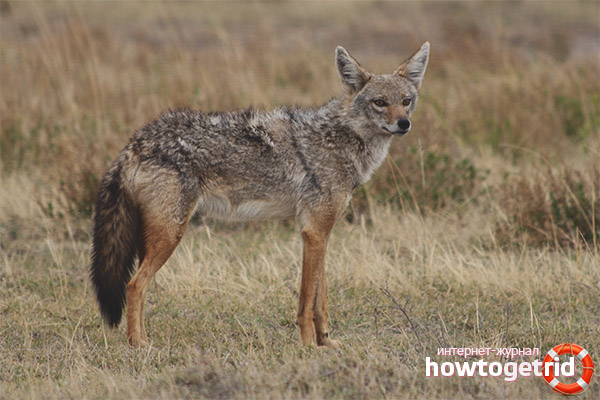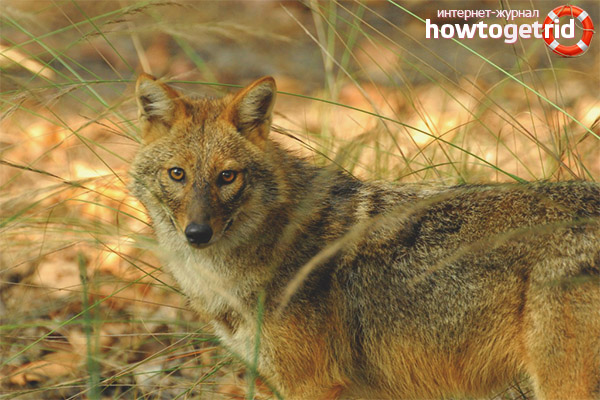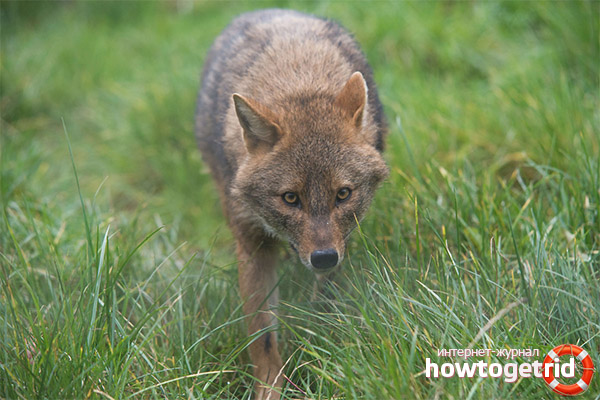The content of the article
Jackals are included in the canine family and are considered predators. They are similar to their relatives, but differ in some habits and ways to get food. If we compare the presented individuals, for example, with wolves, then we can distinguish their smaller overall features. Jackals attack birds and small mammals, however, they can periodically attack animals that are sick. A distinctive feature of jackals can be considered their manner of hiding, waiting for the victim, then abruptly rush at her.
Description
- Mammals are classified as predators of medium-sized characteristics. They belong to the canine or canine family. Introduced in the genus of wolves. Jackals have distinctive features. Among them, a wedge-shaped head, not too massive, with a pointed muzzle.
- The skull can reach 18 cm in length. The canines are strong, medium and sharp. They are not too thin, but adapted for food. Eyes are colored brown, can be dark or light. Ears are erect, spaced at a certain distance, with blunt edges.
- It makes sense to touch on information regarding the color of the animal. It all depends on what region it lives in, what it eats, and to which specific variety it belongs to. In summer, the fur is coarse and short, in winter it becomes soft and fluffy.
Varieties
Individuals of the family under discussion are medium-sized. They differ from each other because there are many varieties. Accordingly, the external data of mammals also vary. But the similarities of all are the same - jackals resemble outbred yard dogs.
- Ordinary. Not too large-sized animal, in external characteristics resembles a wolf, its small copy. Along the length of the body, with the exception of the tail, it extends to 80 cm. Maximum. Adult representatives of the flock at the withers do not grow more than 50 cm. As for the weight category, animals are 9 kg by weight. average. They are pigmented in a gray tone, red blotches may be present. Often gray color is combined with a yellowish or fawn. The dorsal and lateral parts of the body are darker; the abdominal section with the neck is light, yellowed.
- Striped. The muzzle is shortened and extended, a distinctive characteristic is the special color of the case. Thanks to this, the variety got its name. On the side sections there are strips, they are brightened and uniform in pigmentation. The upper part of the body is painted brownish-gray, the tail has a white tip, and he is painted dark. Striped jackals have the strongest and thickest fangs that leave lacerations on the victim's body. The muzzle and the anus are endowed with special glands that emit a specific odor.
- Black-out. A distinctive feature of this type of animal is considered to be their gray-red color, which may be accompanied by the presence of darkened bands in the back. It is this pattern that forms the so-called shabrack, which extends up to the tail. This is a baseball and served as the basis for the name of the variety. As for the dimensional data, individuals grow up to 80 cm along the trunk, and their tail has a length of about 30 cm. The height at the withers ranges from 45–55 cm. The body weight is also impressive and amounts to 13 kg.
- Ethiopian. The animal is characterized by excessively elongated limbs and the same face. External data are similar to the characteristics of the rest of the family, but only partially. By color, these jackals are red, dark.They may have bleached or white marks on the neck, chest, and inner parts of the paws. Some representatives of the species are characterized by the presence of spots on other sections of the body. The upper zone of the tail, as well as the area behind the ears, is painted dark, almost black. Males grow up to 16 kg in mass., Females are slightly less, their weight varies within 12 kg. Jackals reach a height of 63 cm in shoulder height.
Lifestyle
- The main characteristic of these individuals can be considered that they prefer to stay awake mainly at night. Each married couple chooses and conquers a separate territory from their brethren for hunting. Usually the plot is large. The nature of the dogs is rather incredulous, they do not like people and strangers, lead a hidden lifestyle.
- Animals of ordinary species do not wander from place to place, preferring to be constantly in the same territory. These animals do not undergo seasonal migrations, learn to adapt to the surrounding places and seek food where they are. In some cases, on harsh days, they can go very far from their places of residence. There they seek food, they can attack livestock, eat carrion and hunt wounded ungulates.
- Representatives of the canine family, included in the Ethiopian variety, love to hunt. They are cunning, clever, smart. They can accompany a pregnant horse or a cow until it gives birth. After the baby is born, jackals feast on the abandoned placenta. This variety is monogamous and territorial, is hostile to any individuals who come to the selected site.
- Representatives of the black-backed variety are perhaps the most contact and gullible. It is they who, to a greater degree, are peacefully disposed towards people, therefore they can communicate with a person without harming him. Some even adapted to keep such jackals at home, teaching them all the necessary habits.
- All young animals, regardless of variety, after birth, do not leave their native places. The younger generation enters flocks consisting of about 5-8 individuals. There are many males in some flocked areas. This is due to the fact that females have the habit of leaving their homes and going to other areas.
Habitat
- Striped jackals are common in Africa, more precisely in its central and southern parts. In this area, individuals prefer to settle next to a person, they are also present in the savannah and semi-desert zones. Of course, in these places there are other species, but striped are most common. Sometimes they belly side by side with their relatives of other species. Black jackals are common in South Africa; they are located near Namibia.
- As for ordinary individuals, representatives of this species live in many climatic regions and regions. They love bushes, reeds, areas near water sources, as well as abandoned canals and copses. Mammals rise up to 2.5 km into the highlands. up. In foothill areas are less common.
- A distinctive feature of individuals is their ability to tolerate high air temperatures. They live at 35 degrees, without feeling discomfort. On the other hand, these individuals are categorically not adapted to make movements in the snow and especially ice. They move along paths trodden by other creatures.
Diet
- It should be noted that the considered individuals feed mainly on small mammals and various fruits. Sometimes jackals feast on all kinds of insects. The largest prey that the animals in question can hunt is the hare.
- Striped jackals differ from other relatives in that they have a minimal amount of carrion in their diet. Such animals still prefer live food and insects.
- As for ordinary jackals, in this case such animals eat everything they have to. They begin to show the greatest activity with the onset of twilight. Specifically, in this case, such jackals have carrion as the basis of their diet.
- In addition, adult individuals constantly actively hunt small animals and birds, feast on lizards, frogs, snails, snakes, larvae and insects. Near the ponds, jackals often feed on dead fish. In winter, predators attack waterfowl.
- Often, the presented individuals go hunting alone. Sometimes they can do this in pairs. In this case, the first will drive the victim, the second will kill her. It is worth noting that jackals jump very high, so often they catch a bird precisely in a jump. Such carrion animals eat carrion with vultures.
- Often, jackals are the victims of turcians and pheasants. In addition, the adults in question actively and in large quantities eat various fruits and berries. When jackals settle nearby with a person, the animal has the opportunity to eat various garbage waste. Therefore, predators can often be observed in landfills.
- It is worth noting that the animals presented have a loud voice and scream. It is before going hunting that the jackals emit a characteristic howl. Something like a whining and high scream. At this moment, such a howl is picked up by other relatives throughout the district.
- Separately, it is worth mentioning the Ethiopian jackal. The diet of such animals is mainly based on rodents. Such predators very actively prey on large mole rats and other equally large representatives of this family.
- In addition, Ethiopian jackals quite often attack different types of mice and rats. In addition, the considered predators prey on cubs of antelopes and hares. During the hunt, jackals track down prey in the open. As for livestock, jackals attack him extremely rarely.
Breeding
- The jackal breeding period can vary greatly due to the location in which they live. After mating, the female carries offspring for about 2 months. Most often in the rainy season 4 cubs are born.
- The considered individuals equip themselves with a dwelling in the old burrows of the aardvark or termite mounds. It can often be observed that before giving birth, the female independently digs a hole for herself and completely equips it. The male does not participate in this.
- As soon as puppies are born, the first few days the male constantly brings food to the hole to feed the female. She, in turn, feeds babies with milk. The lactation period in the considered individuals lasts about 10 days. After that, the male and the female begin to hunt together and feed offspring.
- Striped jackals are monogamous and after pairing continue to live this way all their lives. The same applies to ordinary representatives of this species. Only in this case, the male independently equip the hole for a long time, before the female is ready for childbirth.
- In ordinary jackals, the mating season most often occurs in late winter or early spring. When the males start the race, they constantly howl and loudly howl. Pregnancy also lasts about 2 months. As a result, young growth appears before the onset of summer. The female gives birth in a well-equipped hole, which is located in an impassable place.
- Young growth continues to feed on mother’s milk for 3 months. But it is worth noting an interesting fact, already at the age of 3 weeks, the female begins to give the puppies other food. She chews it and swallows it. Then he spits up the young. As soon as autumn comes, the puppies already become completely independent. They begin to hunt prey. Most often they do this one by one.
It is worth noting that, regardless of the species, jackals have enough natural enemies. The greatest danger for them is almost any predator that is slightly larger and stronger than the considered individuals. Most often, wolves hunt jackals if their habitat is in contact. If the animals represented live close to people, even yard dogs can bite jackals.
Video: Common Jackal (Canis aureus)













Submit